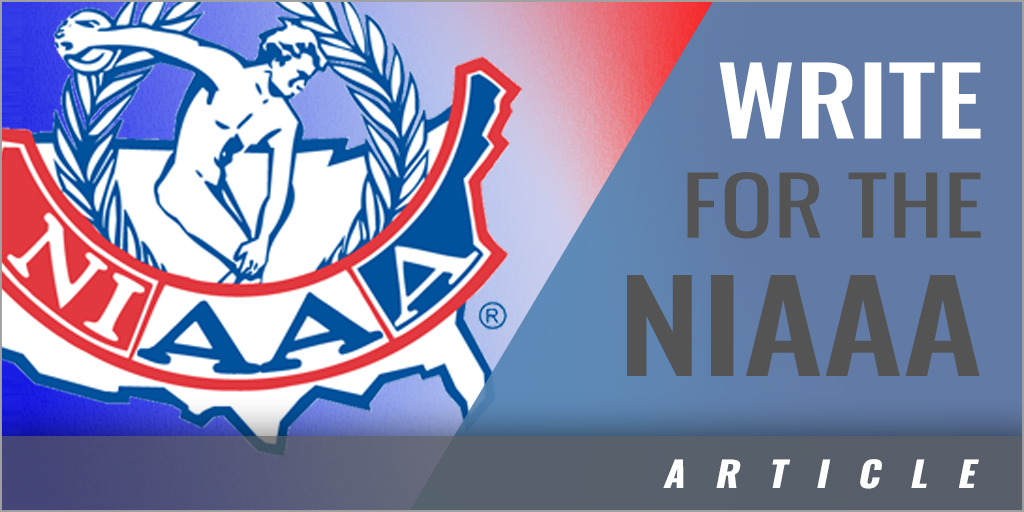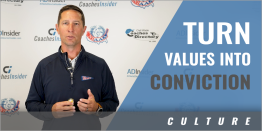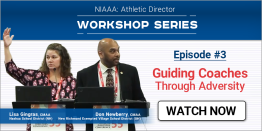|
By: Gary Stevens, Athletic Administrator - Thornton Academy, Saco, Maine When I joined the NIAAA Publications Committee following the 2006 National Athletic Directors Conference, little did I realize what a wonderful professional journey that I would be undertaking. For the next eight years I worked with a highly talented group of athletic administrators, many of whom found their way into the NIAAA Hall of Fame. Working alongside NIAAA legends such as Dr. John Foley, Roy Turner, and Johnny Evers, I was given the gift of a lifetime - an opportunity to learn from education-based athletics leaders who were truly "the best of the best." In addition to completing special projects assigned to the committee by the NIAAA Board of Directors, the major work of the Publications Committee centers around collecting and formatting content for Interscholastic Athletic Administration Magazine. The magazine is a peer journal produced for athletic administrators by athletic administrators. Members of the group read and assess submissions to the magazine, identify potential topics for future articles, work with authors to edit and refine their content, and organize the annual Blue-Ribbon Panel that convenes at the National Athletic Directors Conference (NADC). A true "working" cohort of professionals, the Publications Committee traditionally meets twice per year - at the NADC in December and at the NIAAA Office in Indianapolis in July. One of the things that I learned at my very first meeting was that Publications Committee members must be willing to roll up their sleeves and contribute to the final product that is Interscholastic Athletic Administration (IAA) Magazine. Many of the articles that can be found within the pages of this periodical are crafted by people who themselves serve on the group. Ideas for article content are oftentimes born during group conversations conducted at one of the bi-annual meetings. The committee member who suggests a topic that may be of current interest to the 12,000 readers who comprise the current membership of the NIAAA may soon find himself or herself being encouraged by a colleague to write an article or find an author. Such was the case when I attended my first summer meeting in 2007. As committee members began listing some of the major issues facing the professional organization, I contributed the idea that many schools were concerned about outbreaks of staph infection or other skin-related diseases within their wrestling or football programs. No sooner did I offer that thought then our vice-chair Johnny Evers of Indiana said, "Write an article!" The result of his challenge: the research and authorship of my first major contribution to IAA Magazine - a piece entitled "The Education of an Athletic Administrator: Using a Team Approach to Address an Outbreak of Staph Infection in the Interscholastic Athletic Program." The article appeared in the Spring 2008 issue of the magazine. Since that initial foray into writing for my peers and colleagues, I have had the honor of being published a number of times in a magazine that means a great deal to me both personally and professionally. As a person who has worked in education-based athletics for over three decades, including twenty-five years as an athletic director, participating as an IAA author gives me an opportunity to give back to a profession that I could never have imagined being part of when I graduated from college in 1983, but has nevertheless proven to be the right place for me. Watching the endless turnover of athletic directors moving through the turnstiles of our profession, I am committed to help others learn from my experiences, my successes, and my failures. The written word is truly powerful, and if any of the ideas, concepts, or templates for action that I have articulated over the years can help another, the time spent developing content for my articles has been well worth the investment. I will not win any Pulitzer Prize - or any other award for my writing, for that matter. My sentences can be occasionally complex, and I am a frequent violator of the maxim that "less is sometimes more." Although I try to avoid being preachy in the articles I author, there are times that I detect myself being in lecture mode when rereading those pieces upon publication. I am an athletic director, after all, not a professional writer. The NIAAA Publications Committee is always looking to expand its roster of authors or contributors to IAA Magazine, and the next potential recruit is more likely than not reading these words. Many athletic administrators are reluctant to contribute their thoughts to the publication for reasons that each one of us in the profession can relate to - a lack of time in their personal schedule, a chronic case of "writer's block," or not knowing where to start. (Johnny Evers solved that last problem for me!). For those of you who may be hesitant to join the list of athletic administrators who have contributed to this important peer-reviewed journal on education-based athletics, please understand that your voice is not only important, but also necessary, for the people who serve our profession. The IAA magazine relies upon having a rich and diverse array of contributors in order to provide content and information that meets its wide audience. I hope that you will consider taking a plunge into the world of writing to share your stories, experiences, and perspectives.
I would offer the following bits of advice to any readers who are considering the possibility of taking this vital step to serve our membership. The most difficult part of the process is getting started. Hopefully one or more of these insights will assist you in joining the list of IAA contributors. 1. You are writing for a friendly audience. IAA is a periodical written by athletic directors for athletic directors. With the membership of the NIAAA having surpassed the 12,000-person threshold, the magazine has never been a more important vehicle for sharing current trends in athletic administration, best practices, and news about NIAAA professional development offerings. One of the greatest strengths of the organization is that every person - every voice - matters. When considering taking the leap from magazine consumer to magazine contributor, keep in mind that people in our profession are hungry for information and are supportive of people who have something helpful to offer. Your description of a mundane or repetitive practice for you could be an epiphany for a new or inexperienced colleague. Every person - even the most prolific or accomplished writer - must start somewhere. 2. Write about a topic that interests you. The best way to get beyond writing the first sentence or first paragraph of your initial foray as an author is to develop a topic that you feel confident about. In addition to selecting a topic that is of interest to you, consider writing about a current initiative or program that you have introduced into your school or a pet project of which you are particularly proud. Although research-based articles are always appropriate for submission and will generally be published, the vast majority of IAA readers are looking for ideas about how to improve their craft. Your submission about the work that you are doing at your school may foster a connection as readers reach out to you. 3. Don't worry about the length of the submission. Although some articles may run from 1600-2000 words, there is no minimum length of a contribution to Interscholastic Athletic Administration magazine. In many cases, the most powerful articles are the shortest in length, exemplifying the adage that "less is more." The magazine includes various types of articles in each issue, including:
The success of the magazine depends upon all of these components - articles both long and short. 4. "Hang on! Help is on its way!" The words of this old song performed by Australia's Little River Band were never truer when it comes to the IAA writing process. For those articles that may need some tweaking or minor improvements, the NIAAA Publications Committee will frequently assign a member to work directly with you. Even the best pieces of writing, including those on the New York Times best seller list, are usually reviewed or edited by others who, in turn, offer critiques. An NFHS staff member also supports the work of the Publications Committee in producing the final copy by masterfully incorporating pictures and graphics into the end product. Regardless of any changes or alterations, the article will still be attributed to you and appear in its final form in your voice. 5. Interscholastic Athletic Administration magazine readers love lists. Although not essential for every article submitted to the magazine, lists or bullet points of ideas remain a popular feature among IAA readers. Not only do these components provide that recipe for success that each and every athletic administrator is seeking when solving a specific problem, they also help to break up the text of longer articles, thus reducing the prospects of reader fatigue. Many athletic directors like to copy specific articles and issue them to coaches or colleagues for their consideration. Summaries of key steps or considerations provide templates for thinking and planning for those readers seeking more information about a topic of interest. 6. Make the experience personal. The vast majority of articles that I have written in the fifteen years that I have contributed to Interscholastic Athletic Administration magazine involve designing strategies for addressing problems that I or my colleagues have faced. Sometimes I find it helpful to jot down ideas about how I might manage a challenge that a person in my conference or state association is confronting. By the time that I have finished identifying my approach if I was in that person's shoes, I have developed the outline for an article. The rest of the process involves weaving a narrative out of those steps. The writing process is not easy for everyone, but fear of failure or a history of writer's block should not deter anyone from trying. As a leader in your school, you are both the face and the voice of your athletic program and your vision sets the agenda for everything that occurs on your watch. Sharing your successes, strategies, and stories is a great way to "pay it forward" to other colleagues, who will, in turn, benefit from those experiences. In many cases, those same consumers of your words may reach out to you, thus creating a professional connection that is both rewarding and empowering. The most important - and first - step is getting started. |






